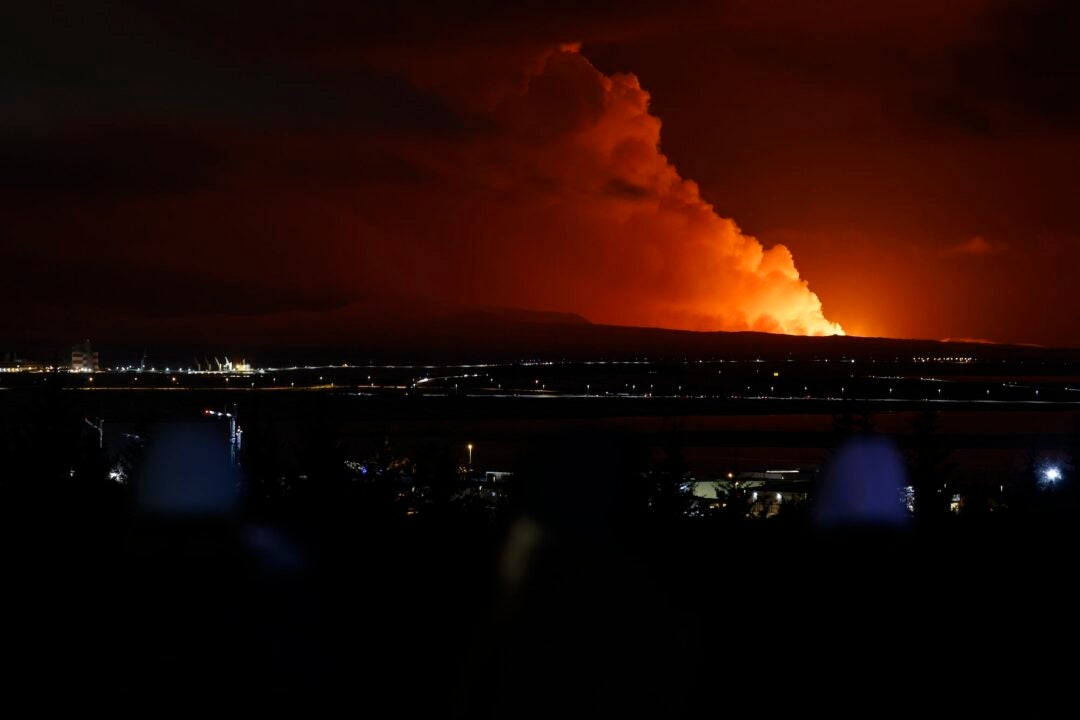Volcano erupts on Iceland’s Reykjanes peninsula weeks after town evacuated
(CNN) — A volcano has dramatically erupted in Iceland, expelling spectacular bursts of lava onto the landscape and emitting huge plumes smoke into the sky after weeks of seismic activity prompted the evacuation of a nearby town.
The eruption on the Reykjanes peninsula began at around 10 p.m. local time (5 p.m. ET), following an earthquake around an hour earlier, the Icelandic Meteorological Office said in a statement.
The office reported that the eruption was located close to Hagafell, about 3 kilometers (about 2 miles) north of the town of Grindavík.
Iceland’s Coast Guard posted a video on Facebook showing one of its helicopters at the scene on Monday night, hovering over a long line of glowing lava spurting from the fissure in the ground. The air is shrouded by smoke and lit in glowing hues of orange and red.
The fissure had formed underground last month, stretching 15 kilometers long, with magma entering into a crack beneath the surface, according to Rikke Pedersen, a scientist and center leader at the Nordic Volcanological Center. On Monday, that fissure reached the surface, with magma flowing from a 4-kilometer long fracture.
This is the fourth eruption in the area since 2021 and the largest so far, said the Icelandic government in a statement Tuesday.
It added that the eruption does not pose a threat to life but said the area was closed to all traffic, and strongly warned people not to approach the area.
Police for the peninsula said Tuesday that scientists would need “several days to assess the situation” and that roads were only open to emergency responders and teams working with the authorities in the “danger zone” near Grindavík. It advised people about the volcano to be “aware that gas emitted from it can be dangerous.”
When the underground magma tunnel formed in November, an evacuation order was issued for Grindavík and nearby settlements preventing residents from staying in their homes overnight as the threat of a volcanic eruption loomed, public broadcaster RÚV reported.
At the time, the country’s Civil Protection Agency warned: “It is clear that we are dealing with events that we Icelanders have not experienced before, at least not since the eruption in Vestmannaeyjar,” referencing a 1973 eruption that began without warning and destroyed 400 homes.
In the first two hours of the eruption, hundreds of cubic meters of lava were being released per second, according to the Icelandic Meteorological Office. But the eruption’s intensity, and the level of seismic activity in the area, had decreased by early Tuesday, with lava spreading laterally from either side of the newly opened fissures.
The town of more than 3,000 people is now clear of residents, RÚV reported on Tuesday, citing police. It is a popular place for tourists because it lies some 7 kilometers from the famous Blue Lagoon geothermal spa.
Pedersen said it is difficult to say how long the eruption will last, as it depends on the supply of magma from underneath the surface – meaning the eruption could go on for anywhere between a week to several months.
There were no immediate disruptions to flights to and from Iceland, and international flight corridors remain open, the government said.
It added that fissure eruptions do not usually result in large explosions or significant production of ash dispersed into the stratosphere.
Icelandair released a statement on Tuesday morning, reiterating that the incident had not affected their flight schedule. The country’s national carrier added that it was monitoring the situation and would keep passengers informed of any further developments.
The Blue Lagoon, which draws tourists to its steaming water, had closed for a period last month after the initial signs of a potential eruption. It had just reopened to guests on Sunday – but said on Tuesday that it was temporarily closing again due to the eruption.
Authorities also said in November they were preparing a protective trench around a geothermal power plant about 7 kilometers from Grindavík that provides electricity and geothermal water to heat homes for a population of 30,000 on the peninsula.
Home to volcanoes
Iceland sits on a tectonic plate boundary that continually splits apart, pushing North America and Eurasia away from each other along the line of the Mid-Atlantic Ridge. It is home to 32 active volcanoes.
As such, the island nation is accustomed to volcanic eruptions, though they often occur in the wilderness, away from populated areas. The Bárðarbunga volcanic system situated in the center of the country erupted in 2014, producing lava that covered 84 square kilometers (32 square miles) of highland that didn’t damage any communities.
The Fagradalsfjall volcanic system erupted in 2021 for the first time in more than 6,000 years. It also didn’t threaten populated areas and even became a tourist attraction as people flocked to witness the eruption.
Experts don’t expect a volcanic eruption to cause the same level of chaos as that seen in 2010 when the Eyjafjallajökull volcano erupted, since it is unlikely to involve the glacial ice that led to a huge ash cloud.
About 100,000 flights were canceled, affecting 2 million people, as a result of the ash spewed out by the 2010 eruption, which threatened to stall aircraft engines and cause electrical failure.
“Eyjafjallajökull involved an eruption through or next to glacial ice that melted and provided water that made the eruption more explosive than it would otherwise have been, hence the high eruption plume and very wide ash dispersal,” Lionel Wilson, Emeritus Professor of Earth & Planetary Sciences at Lancaster University, told CNN last month.
This is a developing story and will be updated.
